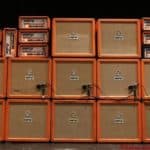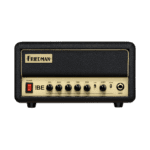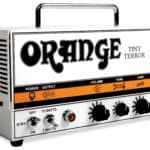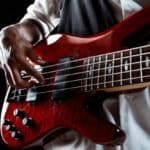After some time playing the guitar, you can feel that the hours you have been practicing were worth it and you can notice how have you improved.
At that moment you think that you are capable of being part of a band and playing live.
However, you wonder if your starter kit is enough to do it.
You start thinking that your 20–watt amp is not the way to go to play on stage but how many watts do you need to gig actually?
Playing live with a drummer will require at least 50 watts of amp power to match its volume. Headroom is important also since you will struggle to get clean sounds at high volumes with 50 watts. For clean tones, 100 watts is the standard. Remember you can also mic up smaller amps and go through the PA.
Choosing your equipment is not an easy task but let me help you with this overwhelming issue.
In this article, we explain the importance of amps wattage and how it affects your sound, continue reading and we will evacuate every doubt as regards this topic.
Watts are not a synonym of volume
Although watts are related to volume, it isn’t the only aspect.
Wattage is in fact more related to power which is not the same as the volume.
The number of watts in an amp determines the power, some players think that if they double the wattage they are doubling the volume as well but that’s not true.
Watts and volume are related exponentially instead of linearly.
If you want to double your volume what you have to do is multiply the number of watts by ten.
Furthermore, a ten watts amplifier won’t have a lot of difference from a twenty watts amp.
And going from 50 watts to 100 watts will get you only a 3 dB rise in actual loudness.
Are tube amps actually louder?
Tube amps are generally thought of as louder than solid-state ones and they actually are.
A low-wattage tube amp (10 or 15 watts) will sound louder than a 30 watts solid-state amplifier.
That is because of speaker impedance, which is the total resistance that a speaker offers to the current that flows through it.
As in solid-state amps, the signal is hard clipped, the available power is strongly reduced which gives more speaker impedance but less overall power.
In the case of tube amps, they faithfully produce between 80% and 90% of the signals sent by the instrument.
In addition, their smooth, over-driven tone when they are cranked up is less harsh and more tolerable which makes them able to sound louder.
Can you gig with a 5-watt amp?
A 5-watt amp has commonly a 1 x 12 speaker and these gears are not able to achieve volumes enough to play with a drummer for rehearsals or gigs on stage without PA support.
Even hooked up to a PA system via a microphone this kind of amp may probably sound “small”.
5-watt amps are designed to play at suitable volumes required within a bedroom or at home.
If you want to get a “bigger” sound using this gear what you can do is get additional speakers, these cabinets will give you a thicker tone and you can notice a huge difference but the volume would still not be enough to gig.
Are small 10 watt amps loud enough to gig?
10-watt amps are still beginner gear made for practicing at home and again, PA support will be needed.
If you have this number of watts, think of playing alone without any other musicians.
However, small 10 watt amps might be nice for busking.
It always depends on what are your expectations but they could be useful for small gatherings of people who want to listen to you and your guitar.
Are 25 watts enough to gig?
Assuming you don’t need crystal clear sound, 25-watt amplifiers could be enough but they can make some unwanted noises while playing.
Needless to say, it always depends on the style of music you want to play and the tone you want to achieve.
Nevertheless, these amps may be too “thin” for playing with other musicians.
Acoustic drum kits are loud, especially if you play music genres that require a hard-hitting drummer such as hard rock or metal.
Standard bass amps could easily drown your low wattage guitar amp and if you are in a band with another guitarist who tends to crank his higher wattage amp up, you will have serious sound problems.
The audience could have a hard time making up what you’re performing, and what is even worst, you wouldn’t hear yourself playing.
50 watts could be enough to gig for some players
50-watt amps are the starting point for a gigging amp without the help of any microphone, what I mean to say is this wattage is maybe the minimum threshold to play live.
Up to this point, the difference between solid-state and tube amps is really relevant.
If your goal is to use a solid-state amp, the higher the wattage, the better.
This is because as you intend to sound loud, you don’t want to crank up your amp and as you need some leftover headroom to maintain your tone clean, you won’t want to push your gear to its limits.
On the other hand, tube amps reach their best tone when they are pushed.
Consequently, in this case, you do want to break up the amp to its limits.
Keep these points in mind when choosing an amp to gig with your band.
In the case of tube amps, they’ll be enough because you will be looking for your amp to crank up.
However, 50-watts solid-state amps won’t be enough for the same situation.
You will need to push the amp to its limits to be heard and that will produce a poor sound and, what is worst, you could damage your equipment.
Keep in mind that 50 watts are still not recommended for clean tones.
100 watts or more will be enough for any gig
100-watt is the gold standard for gigging amps.
These are big boys which will pummel your audiences with their power.
These kinds of amps will have enough volume to gig and, what is more, you won’t have any problem when pushing them to the limit due to the headroom they provide.
You won’t have to deal with clipping or unwanted distortion and you can also play maintaining a fine clean tone in both kinds of amps, solid-state or tube amps.
What is headroom and why do you need it for gigging?
Headroom is the slack the amp has to keep clean tones clean.
Amps when cranked start distorting.
A high watt amp will not be required to be cranked for it to sound loud enough to gig with, so you will still be able to use clean tones at high volumes.
Headroom is simply a term that refers to and describes how much power your amp can provide before to start cranking or sounding distorted.
Some amps are intended to provide a lot of clean headroom and this is great to keep a pure clean sound at high volumes.
Contrarily, some other amps are created to provide a distorted sound before cranking.
That is because they are designed to provide less headroom because the distorted sound they produce is perceived as something good by the human ear.
Furthermore, amps that possess a high wattage don’t need to be cranked to sound loud enough to gig.
In that way, you will have loud clean tones despite having high volumes when playing.
Conclusion
To sum up, choosing your amp is one of the most important parts of being a guitar player.
You need to be sure about your expectations and decide what are you going to use it for.
If your intentions are gigging and giving concerts, you need to go for a high wattage amp to not sound small while playing live.
Whether to choose between solid-state or tube amp is completely up to you, try to choose something that suits your playing style.
However, if you are a beginner and you just want to play at bedroom levels, go for a low-wattage amp.
Anything between 15 and 30 watts would be loud enough but if you want to have a better understanding of this, we have articles about this topic.

Hello there, my name is Ramiro and I’ve been playing guitar for almost 20 years. I’m obsessed with everything gear-related and I thought it might be worth sharing it. From guitars, pedals, amps, and synths to studio gear and production tips, I hope you find what I post here useful, and I’ll try my best to keep it entertaining also.





